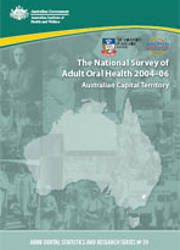Summary
This report presents findings from the ACT component of the 2004–06 National Survey of Adult Oral Health (NSAOH). Information was collected using interviews and standardised dental examinations that were conducted among a random sample of ACT residents aged 15 years or more. Three major themes are reported in chapters describing oral health status, oral health care and perceptions of oral health. Statistics summarising those themes are tabulated for the ACT adult population and for three age groups that are further classified according to: sex, residential locality, socioeconomic status of the area in which they live, government health cardholder status and dental insurance.
The 2004–06 NSAOH took place 17 years after the first oral examination survey of Australians conducted in the six states and the Australian Capital Territory (Barnard 1993). State/territory reports from that 1987–88 National Oral Health Survey of Australia (NOHSA) highlighted variations among age groups, between the sexes and between people living in or outside capital cities. The major findings reported from the survey were:
- children’s dental decay rates were low by historical standards and when compared internationally
- nearly one-half (48%) of adults had made a dental visit within the preceding year, the majority of them to a private dental practice (88%)
- however, 44% of adults were found to need one or more dental fillings
- the percentage of Australians with complete tooth loss had reduced compared with earlier interview surveys although 50% of people aged 65 years or more had no natural teeth and
- one of the four national oral health targets had been achieved and it was expected that the remaining three targets would be achieved by 2000.
However, the first survey did not collect information about government health cardholder status or socioeconomic status, and results were not contrasted between insured and uninsured.
In the 17-year period since the NOHSA, there has been substantial growth in public sector dental care and dental insurance. Increasingly, national and state/territory health goals call for reductions in socioeconomic inequalities in health, including oral health. For those reasons, this report includes a focus on the relationship between oral health and indicators of socioeconomic status and access to dental care, as well as the traditional demographic markers of age, sex and residential location.
Preliminary material: Abbreviations; Symbols; Acknowledgments; Overview of results
1. Introduction
- Purpose and organisation of this report
- Background to the survey
- Aspects of oral health and dental care relevant to the National Oral Health Plan
2. Methods
- Study population and sampling
- Sampled postcodes
- Computer-assisted telephone interview
- Oral epidemiological examination
- Period of data collection
- Ethical conduct of research
- Target sample size
- Participation in the survey
- Data analysis
- Distribution of sociodemographic and dental access characteristics
3. Oral health status
- Complete tooth loss
- Inadequate natural dentition among dentate people
- Denture wearing by dentate people
- Average number of teeth per person missing due to pathology
- Prevalence of untreated coronal decay
- Percentage of people with untreated root decay
- Percentage of people with one or more filled teeth
- Average number of decayed, missing and filled teeth per person
- Prevalence of moderate or severe periodontitis
- Prevalence of deep pocket depth
- Prevalence of 4+ mm clinical attachment loss
- Prevalence of gingival inflammation
4. Oral health care
- People's most recent dental visit
- Attendance at private dental practice
- Payments by patients for dental care
- Government-subsidised dental care in private sector
- People's usual pattern of dental visits
- Usual attendance at the same dentist
- Usual dental attendance for a check-up
- Dental care avoided or delayed due to cost
- Recommended dental treatment foregone due to cost
- Difficulty paying a $100 dental bill
- Percentage of people avoiding foods due to dental problems
5. Oral health perceptions
- Percentage of people rating their oral health as fair or poor
- Percentage of people experiencing toothache
- Percentage of people experiencing orofacial pain
- Perceived need for dentures
- Perceived need for dental extraction or filling
- Perceived need for a dental check-up
- Perceived urgency of dental treatment nee
- Age-standardised comparison between government health cardholders and non-health cardholders
- Age-standardised comparison between the dentally insured and the uninsured
Appendix: Sample counts
End matter: Glossary; References; List of tables



